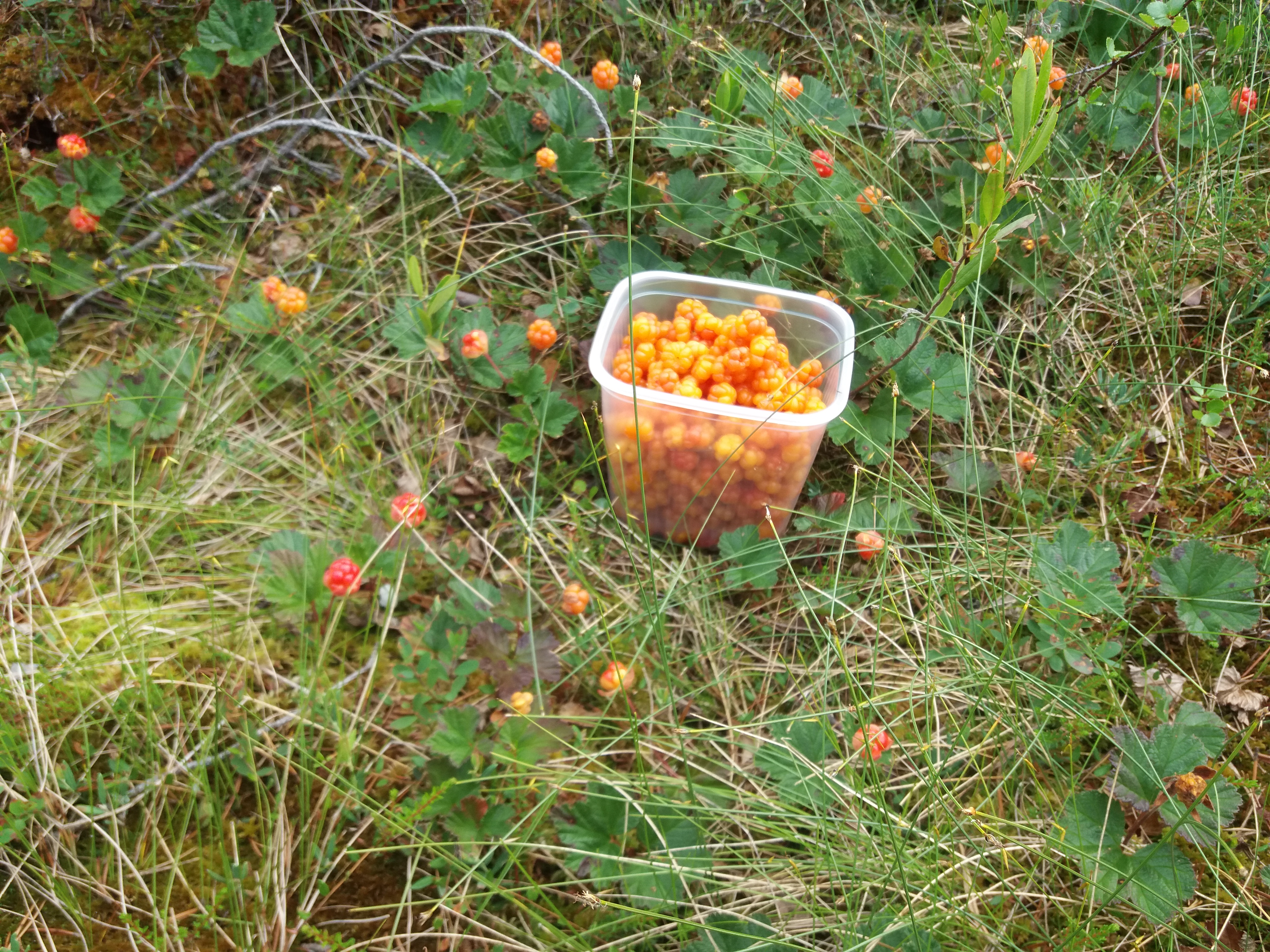Energy consumer device 1: Freezer. Conserving cloudberries in a city
For somebody who ponders energy issues on a daily basis, it is probably normal to reflect her own personal energy consumption, habits and practices. This text is about my conserving wild forest berries.

Image: Cloudberries. Photo: Sini Numminen, 2020
This summer I picked a lot of cloudberries. I found them in the woods of North Karelia of Finland (Pohjois-Karjala). This was an exceptional year. The locals told me there hasn’t been so many cloudberries since the early 1990’s. Cloudberries are rare, special and expensive. And picking them is hard work: you must deal with swarms of mosquitoes and other bugs and cross hard-to-get wetlands. Just a couple of days ago, the price in a Helsinki supermarket was 20€/kg which was a relatively good offer, in comparison with previous years. However, I was not going to sell my harvest. To be able to enjoy their sweet and vitamin-rich taste over the upcoming winter, I want the best storage conditions for my precious cloudberries.
Freezing berries in small boxes is a good option. That way the berries keep their original shape and taste. This summer was also an exceptional blueberry year, which means the fridge-freezer in my kitchen could not bear all of it. Therefore, I had to plug in a second, smaller fridge (of around 80 litres, ~150 kWh/year). Assuming I will need it running and refrigerating for the next 6 months, I will need an extra 75 kWh of electrical energy for the storage. Is this a high amount or not? In comparison with the power draw of many other devices, an average 17 Watts is not very much (=150kWh/a/8736h/a). A Wi-Fi router may easily waste this amount of electricity. Let alone just the standby of large TV screens, when talking about wastage. Many people don’t know the power draw of every single device they have – neither do I. (Why? I probably should come back to this topic later on). A CO2 calculator, referring to the Energy Authority database says that one kWh of electricity consumed in Finland produces 290 grams of CO2. This berry freezing project of mine, therefore, produces ~22 kg of CO2 = 0.022 tons of CO2.
As we know, tiny streams form a river, so let’s make a small hypothetical calculation. I heard on the radio, that 3 million Finnish people label themselves as berry-pickers (that’s quite a lot out of 5.5 million inhabitants!). Let’s assume, that maybe 30% of these people are hard-working berry-harvesters and need extra cold storage, and typically there are two people living in a household. Of course, many berry-pickers probably live with other berry-pickers, but I assume an equal distribution of berry-pickers within the population, results in 500 000 freshly-initiated freezers humming. If my logic has any sense all this would lead to eleven thousand tons of carbon dioxide (=3000000X0.3X0.5X75 kWhX281g_CO2ekv/kWh)! Could this be correct? Could somebody with experience in CO2 calculations please confirm this or correct me if I am wrong?
To put it simply, an annual berry-storing project of my fellow citizens and I may produce eleven thousand tons of carbon dioxide! When 17 Watts of power sounds small, 11 tons of CO2 no longer does. Could we change this practice? Could there be less freezers? Notwithstanding that the initial idea of putting a freezer on just for the sake of some cloudberries sounds a bit crazy. Because cloudberries contain natural preservatives their freezing is actually not necessary. My grandmother simply kept her berries in their buckets in a cool underground cellar. I could alternatively make delicious and sweet cloudberry jam, seal the jars, and place them the same cellar. But where is my cellar? I live in Helsinki, in an apartment block, built in the 1960’s, and I believe there must have been a common cold storage room somewhere in the building or nearby. I suspect that is no longer the case. In the olden times, there were no freezers in these apartments, which I can say by looking a ta hole in our kitchen wall (which is filled up now, of course, but the remainder is there). Those types of holes allowed cold air from outside to access a cold space/room/box indoors for storing groceries.
Even though berry-picking and eating might easily justify my additional 17 Watts consumption (I will buy less imported fruit and berries, for example. I will also use the 17 Watts for storing wild mushrooms which reduces the consumption of other proteins - like meat -, and is good for health etc.), I am still asking: where is the cellar? Could there be cellars in cities?
Sources:
OpenCO2.net. (2019). Päästökertoimen tiedot. Suomen keskimääräinen sähkönhankinta, kansallinen sähkön jäännösjakauma, URL: https://www.openco2.net/fi/paastokertoimet/sahko/suomen-keskimaarainen-sahkonhankinta-kansallinen-sahkon-jaannosjakauma/1177 (accessed 27 August 2020)
More information on cold storages in Finland (in Finnish): Ruokatieto.fi: “Keittiön koneellistuminen 1900-luvulla”, URL: https://www.ruokatieto.fi/ruokakasvatus/hyva-tavaton-ruoka-ja-tapakulttuuri/nykypaiva-rakentuu-historian-paalle/keittion-koneellistuminen-1900-luvulla (accessed 27 July 2020)